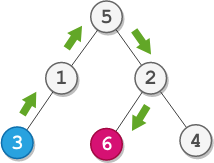- {x}
- Count Fertile Pyramids in a Land
- Find Target Indices After Sorting Array
- K Radius Subarray Averages
- Removing Minimum and Maximum From Array
- Find All People With Secret
- Minimum Cost to Reach City With Discounts
- Finding 3-Digit Even Numbers
- Delete the Middle Node of a Linked List
- Step-By-Step Directions From a Binary Tree Node to Another
- Valid Arrangement of Pairs
- Subsequence of Size K With the Largest Even Sum
- Find Subsequence of Length K With the Largest Sum
- Find Good Days to Rob the Bank
- Detonate the Maximum Bombs
- Sequentially Ordinal Rank Tracker
- Rings and Rods
- Sum of Subarray Ranges
- Read More...

Step-By-Step Directions From a Binary Tree Node to Another
You are given the root of a binary tree with n nodes. Each node is uniquely assigned a value from 1 to n. You are also given an integer startValue representing the value of the start node s, and a different integer destValue representing the value of the destination node t.
Find the shortest path starting from node s and ending at node t. Generate step-by-step directions of such path as a string consisting of only the uppercase letters 'L', 'R', and 'U'. Each letter indicates a specific direction:
'L'means to go from a node to its left child node.'R'means to go from a node to its right child node.'U'means to go from a node to its parent node.
Return the step-by-step directions of the shortest path from node s to node t.
Example 1:

Input: root = [5,1,2,3,null,6,4], startValue = 3, destValue = 6 Output: "UURL" Explanation: The shortest path is: 3 → 1 → 5 → 2 → 6.
Example 2:

Input: root = [2,1], startValue = 2, destValue = 1 Output: "L" Explanation: The shortest path is: 2 → 1.
Constraints:
- The number of nodes in the tree is
n. 2 <= n <= 1051 <= Node.val <= n- All the values in the tree are unique.
1 <= startValue, destValue <= nstartValue != destValue
Solution Explanation: Step-by-Step Directions From a Binary Tree Node to Another
This problem asks for the shortest path between two nodes in a binary tree, represented as a string of 'L', 'R', and 'U' characters. Two solutions are presented, both leveraging the concept of the Lowest Common Ancestor (LCA).
Core Idea: The shortest path between two nodes always goes through their Lowest Common Ancestor (LCA). The LCA is the lowest node in the tree that is an ancestor of both nodes.
Solution 1: LCA + Separate DFS
This approach involves three steps:
-
Find the LCA: A recursive function
lcafinds the LCA ofstartValueanddestValue. It returns the LCA node. If a node's value matches eitherstartValueordestValue, it's the LCA if it's an ancestor of both; otherwise it continues recursively through left and right subtrees. -
DFS from LCA to targets: Two separate Depth-First Searches (
dfs) are used, one starting from the LCA node and going tostartValue, and the other going todestValue. Eachdfsgenerates a path string ('L' or 'R' for each step). -
Construct the final path: The path from the LCA to
startValueis reversed and represented by 'U' characters (because we're going up the tree). This reversed path and the path from the LCA todestValueare concatenated to form the final result.
Solution 2: LCA + Single DFS (Optimized)
This solution is more efficient by avoiding the separate DFS calls. Instead:
-
DFS from root to targets: A single
dfsfunction is used twice, once for each node (startValueanddestValue). Each call builds the path from the root to the target node. -
Find common prefix and construct path: It finds the longest common prefix between the two path strings. The portion of the
startValuepath beyond the common prefix is converted to 'U' characters, and this is concatenated with the remaining portion of thedestValuepath. This directly gives the shortest path.
Time and Space Complexity:
Both solutions have the same complexity:
-
Time Complexity: O(N) - Both solutions traverse the tree at most twice (once for each DFS, or essentially twice for Solution 2). N represents the number of nodes in the tree.
-
Space Complexity: O(N) - In the worst-case scenario (a skewed tree), the recursive depth of the DFS can be O(N), thus leading to O(N) space usage for the call stack and the path strings.
Code Examples (Python):
Solution 1:
def getDirections(root, startValue, destValue):
def lca(node, p, q):
if not node or node.val in (p, q):
return node
left = lca(node.left, p, q)
right = lca(node.right, p, q)
return node if left and right else left or right
def dfs(node, target, path):
if not node:
return False
if node.val == target:
return True
path.append("L")
if dfs(node.left, target, path):
return True
path[-1] = "R"
if dfs(node.right, target, path):
return True
path.pop()
return False
l = lca(root, startValue, destValue)
path1, path2 = [], []
dfs(l, startValue, path1)
dfs(l, destValue, path2)
return "U" * len(path1) + "".join(path2)
Solution 2:
def getDirections(root, startValue, destValue):
def dfs(node, target, path):
if not node:
return False
if node.val == target:
return True
path.append("L")
if dfs(node.left, target, path):
return True
path[-1] = "R"
if dfs(node.right, target, path):
return True
path.pop()
return False
path1, path2 = [], []
dfs(root, startValue, path1)
dfs(root, destValue, path2)
i = 0
while i < len(path1) and i < len(path2) and path1[i] == path2[i]:
i += 1
return "U" * (len(path1) - i) + "".join(path2[i:])The code in other languages (Java, C++, Go, TypeScript, JavaScript) follows similar logic, with appropriate adjustments for syntax and data structures. Solution 2 is generally preferred due to its slightly cleaner implementation and avoidance of redundant LCA finding.